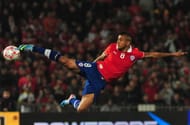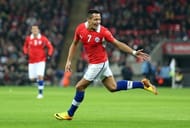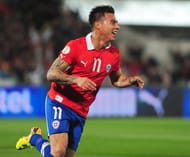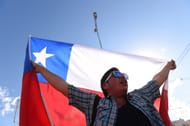When you think of South America and football, the first two names that come to mind to most football lovers are, just like the first two letters of the English alphabet, A for Argentina and B for Brazil. It rarely goes to C…
But C for Chile is something that close followers of the beautiful game and its quadrennial celebration have become accustomed to, for this small nation situated around the Andes Mountains, along Suda America’s western coast, has been one of the most prominent players in the continent’s footballing history. It is only fitting that Chile are mentioned in the same breath as Argentina, Brazil and Uruguay, for it was these four nations that were the founding members of CONMEBOL. That apart, Chile’s football association is the second oldest in South America after Argentina; its origins dating all the way back to 1895.
Their 2014 appearance marks their eighth overall and an appearance at back-to-back finals for the very first time, having made it to South Africa in 2010. In their third finals appearance in 1962, in front of their home fans, the team made it all the way to the semi-finals, but lost out to eventual champions Brazil. However, they finished third, beating the erstwhile Yugoslavia 1-0 in the third place playoff. It is to date their best finish at the World Cup.
Nicknamed La Roja (The Red One), the Chilean football team since the 1960s has constantly been among the 25 strongest football teams in the world according to the World Football Elo Ratings.
2014 qualification
Chile qualified for the 2014 FIFA World Cup via direct qualification by finishing third in the CONMEBOL qualifying section behind Argentina and Colombia, just four points behind the Argentines and two behind the Colombians. They registered as many victories (9) as the top two, with only their infinitely more losses proving to be detrimental in the final standings.
Chile’s qualifying campaign was effectively a story of two halves. They got off to an electric start, winning four of their first six games, including impressive away wins at Bolivia and Venezuela, traditionally tough places for visiting teams. However, they did suffer two resounding losses away to favourites Argentina (4-1 on opening day) and Uruguay (4-0 on Matchday 3) in that initial six-match stretch.
After that fast start off the blocks came the stutter where they went winless in the next three games, including home losses to Colombia (1-3) and Argentina (1-2). That dip in form cost their Argentine manager, Claudio Borghi, his job, and a fellow countryman of his, Jorge Sampaoli, was summoned to take over the reins. His first match in charge didn’t go any differently as the Chileans suffered another reverse as they were beaten 0-1 away in Peru. But that match would prove to be the turning point in Chile’s qualifying campaign as Sampaoli initiated the turnaround that they had sought after as they put together a superb six-match unbeaten run, winning five and drawing one, in the final stretch of their campaign and claim third place in the South American qualification standings.
Form carries over into friendlies
Not only did Chile finish their qualifying campaign with a flourish, they have been mighty impressive in the friendlies that they have featured in as well, and against the best of opponents. Since the beginning of 2013, Chile have played 10 friendlies, of which they have lost only two. The first of those two losses came against Brazil on November 19 last year in Toronto, Canada, where they lost a close game (1-2) to a late winner from Robinho, and the second was on March 5 this year to Germany (0-1) in Stuttgart. That match against the Germans will be well remembered, for though Chile ended up on the losing side, they really should have won that game for they put the German defence to the sword with their attack. Yet somehow, not only did Chile fail to win, thanks to a combination of woeful finishing and desperate German defending, they didn’t even score a single goal, something that looked a certainty as the match wore on. But what it did do is place in full view the offensive capability of this Chile side, potent enough to rip through the very best footballing sides in the world.
And through their fantastic run, they held Brazil to a 2-2 draw in Belo Horizonte, in front of the Selecao’s home fans, in their April 24 meeting last year and also held world champions Spain 2-2 in Geneva last September. La Roja also produced a scintillating display of attacking football in front of nearly 63,000 supporters at the Wembley Stadium last November as they overwhelmed England 2-0 on their home turf.
Attack is the keyword
At the heart of Chile’s remarkable run of form over the last couple of years has been a system that preaches launching quick, swift attacks with an emphasis on pace…pace and more pace coupled with an intense pressing scheme when in not in possession of the ball. Sampaoli’s game plan has reaped much dividend with opposing defences almost always left in a quandary while trying to deal with his team’s attacking potency.
Sampaoli has built on the successes of one of La Roja’s previous coaches, ‘El Loco’ Marcelo Bielsa, who guided Chile to the 2010 World Cup finals. A student of Bielsa, the current coach has continued with the formula that Chilean teams of the past employed successfully and he has been able to count on a group of talented players who are capable of delivering precisely that brand of football.
The Cast
Chile’s squad is expectedly headlined by the names of Arturo Vidal of Juventus and Alexis Sanchez of FC Barcelona.
Vidal has emerged as one of the world’s premier box-to-box midfielders in the last couple of years. After shining at Bayer Leverkusen, he made the switch to Italian giants Juventus in 2011, and ever since, his stock has soared. He has been an integral part of the Bianconeri’s three successive Serie A titles since his arrival and his displays for Chile have been of similar ilk, providing La Roja’s midfield with some defensive steel with his hard-tackling and pressing and also offensive thrust through the middle, joining up in attack and contributing goals and assists. Vidal found the net five times in his 11 qualifying appearances for Chile, making him the top scoring midfielder in South American qualifying. Not for nothing is this man named Il Guerriero (“The Warrior”), for he is as combative as they come. Vidal is coming off yet another successful season for Juve where he pitched in with 11 goals in their title winning league campaign.
While Vidal brings the toughness and hustle, Alexis up front leads Chile’s high octane attack. His electric pace and dribbling skills serve as the perfect weapons in Sampaoli’s system as the Barcelona forward has come to be known for scoring some fantastic goals. Alexis is a joy to watch as he takes on opposing defenders and often leaving them in his trail as he moves towards goal. Under new Barca manager, Gerardo Martino, Alexis enjoyed more playing time than before and benefited from a playing style that complemented his qualities more and he had his best ever season with the Catalan outfit, scoring 19 goals (21 overall) and providing 10 assists (15 overall) in the just concluded La Liga season.
But Vidal and Alexis aside, there is one little guy whose lethal finishing in front of goal could hold the key to Chile’s chances of progressing deep into this World Cup - presenting Eduardo Vargas.
The 24-year-old 5’9” forward, who currently plays for Spanish club Valencia on loan, was joint-top scorer for Chile, along with Vidal, with five goals to his name. He may not have set the stage alight with his performances at club level, but for his national team, Vargas has been in supreme form, scoring 12 goals in his last 15 appearances since the beginning of 2013. His rich vein of form increases the danger posed by Chile to the other teams at this year’s World Cup as they don’t just have to deal with the twin dangers of Vidal and Alexis.
In defence, assured veterans Gary Medel and Juan Cala, provide a measure of comfort for the Chileans while keeper and captain Claudio Bravo, also lends some much needed solidity to the backline. Throw in Marcelo Diaz, who operates in the centre of Chile’s midfield and keeps things ticking over nicely, and you have a team that is bursting with talent in every quarter of the pitch, and one that makes for a very dangerous opponent to any team.
Chile are placed in Group B along with the two finalists from last time around – holders Spain and runners-up the Netherlands – and Australia. It is a tough group to emerge from especially when you have such dominant teams in the fray. But, there are many things going in their favour, namely the home conditions and their familiarity in playing at max levels for 90 minutes in those conditions. Also, as looked at above, the team is in a rich vein of form and as an added bonus will take on the weakest team in the group, in the Aussies, in their first game, thus avoiding the two powerhouses.
Chile’s attack, especially on the counter, can be a handful for any team to manage. And if the opposition’s defence is not at its sharpest, they could be in for a rough ride. And that’s one area where the Dutch have traditionally not been the best – the defence. Chile may not be able to ride roughshod over the defending champions Spain, but they pose a very clear and present danger to a team like the Netherlands.
Interestingly, each time that Chile has progressed beyond the group stages, their campaign has come to an end at the hands of Brazil (round of 16 in 1998, 2010 and semi-finals 1962). And there could well be another match against the Selecao in the offing in the Round of 16 here if Chile makes it through.
Once La Furia Roja and the Oranje finish their boxing match in Group B, they will cast their eyes on the proceedings in the second match of the group where La Roja will take to the pitch to kick-start their campaign. No one will be taking the team from South America lightly as pushovers, knowing fully well that this Chile team has it in them to put one over their more accomplished colleagues.
"I believe Chile will win the World Cup, if I didn't believe that I would be sitting at home in front of the television," added forward Alexis Sanchez, while ‘El Guerriero’ Vidal has exclaimed that this is Chile’s greatest footballing generation ever. It’s a generation that is ready to throw a spanner in the works of the designs of some of their fellow competitors.
A Chile breeze is blowing across Brazil, one that carries with it a latent fear and danger; enough to make the hair on the back of the necks of their opponents stand up in recognition of this team’s capability. Teams at the 2014 FIFA World Cup, you have been warned!





